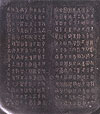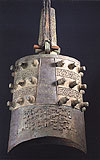Questions on the Reading
|
Week 2
|
|
|
 |
|
|
|
|
| Questions on the Reading for week 2 |
Tuesday: Sources of Chinese Tradition, pp. 41-111.
Thursday: Sources of Chinese Tradition, pp. 112-183, 190-206. *Book
of Songs, poem # 1 and Preface. |
| |
|
Introduction to "Disputers of the Dao: The Way to Order
in the Warring States Period."
The legitimacy of the kings of the Zhou dynasty (ca. 1045-256 BCE)
rested on a nexus of kinship, ritual, and ancestral sacrifice. The
Zhou house claimed the most powerful ancestral spirits with whom
only the royal family could communicate through sacrifice, divination,
and other religious practices. This privileged position materialized
in walled cities, palaces, altars, chariots, and especially elaborate
bronze ritual implements. Such insignia of power were concentrated
in the capital, but they were also bestowed on feudal princes who
ruled outlying regions on the king's behalf.
During the Warring States period (479-221 BCE) the feudal states
defected and waged war on one another. The ideal order collapsed
and with it the basis of its legitimacy. The ensuing chaos and destruction
inspired philosophical queries into new grounds of legitimacy that
would ensure a lasting peace. Most of these philosophers were traveling
political advisors who attempted to gain influence at the contending
courts where they might implement their policies. These philosophers
generally did not doubt the validity of the central concepts that
had underpinned the Zhou dynasty during its heyday. Rather, they
believed that the true meaning of concepts such as "the Way" (dao),
virtue (de), ritual (li), and Heaven (tian) had been lost and attempted
to recover their original, true meaning.
|
| |
|
 |
Map of the Tracks of [the Sage King] Yu. This
seventeenth-century map shows the rather irregular boundaries
of the nine ancient regions or provinces of China supposedly
demarcated by Yu the Great. This reconstruction is based on
a study of the description of these regions in the "Yu
gong" chapter of the Shu jing. It contravenes the
more schematic, geometrized versions of the jiu zhou
(nine provinces) favored by cosmographers of the Han era. |
|
| |
|
| |
The story of the filial Shun. Detail of an
engraved stone slab from a sarcophagus. Late Northern Wei
Dynasty, about 520-530.
|
 |
| |
|
 |
Shi Qiang bronze pan vessel. Middle Western Zhou period,
end of tenth century BCE. From JZhuangbai, Fufeng, Shaanxi
Province.
The Shi Qiang pan vessel is in many respects the most
important of all Western Zhou bronze vessels, a position attributable
almost entirely to its 270-character-long inscription (see
detail below), which might justly be described as the first
conscious historical writing in China. In two balanced halves,
it juxtaposes an outline of the first seven Western Zhou kings
with a similar genealogy of four generations of the Wei family.
The inscription concludes with a prayer that Qiang's own merits
be acknowledged and that he be granted a long life so that
he may contiue to serve the Zhou kings. The inscription is
equally important as evidence for the rise of poetry in China,
being stylistically identical to the four-character rhyming
line structure of the Shi Jing (Classic of Poetry).
|
|
| |
|
 |
English
Translation of the Shi Qiang pan Inscription
|
|
| |
|
|
| |
|
|
| |
Chime of twenty-six bronze zhong bells. Middle Spring
and Autumn Period (c. 550 BCE). Xiasi, Xichuan, Henan Province.
This is the largest continuous bell-chime so far known from
the Chinese Bronze Age. The bells tilt toward the player,
permitting greater accuracy in striking than in vertically
suspended bells--an important feature, since each yongzhong
can emit two notes, depending on whether it is struck in the
center or midway to the side. (The interval between the two
notes usually approximates either a minor or a major third.)
This acoustic phenomenon is caused by the bell's almond-shaped
(pointed-oval) cross section. The chime still emits tones
similar to those heard during the Bronze Age. Its range extends
over five octaves, with up to ten different notes per octave.
The inscribed text, translated below, identifies the individual
for whom this chime was made as the grandson of a Chu king.
|
 |
| |
|
|
| |
Bronze Zhong Bells Inscription
It was the first month, in the first quarter, day dinghai.
I, Wangsun Gao, selected my auspicious metals and for myself
made [these] harmonizing bells. They are long-vibrating and
sonorous, and their fine sound is very loud. With them, sternly
and in a very dignified manner, I reverently serve the king
of Chu.
I am not fearful and make no mistakes. I am gracious in my
administrative demeanor. I am thoroughly familiar with the
awe-inspiring ceremonies. I am greatly respectful and am at
ease and composed. I am fearful and very careful; earnestly
planning [my actions], I am good at defending [my ruler].
For this I am known in the Four States. I respectfully keep
my treaties and sacrifices, and as a result forever obtain
happiness. Martial in warfare, I consider and carefully plan
[my strategies] and am never defeated.
Glistening are the harmonizing bells. With them feast in
order to please and to make happy the king of Chu, the various
rulers and the fine guests, our fathers and brothers and the
various gentlemen. How blissful and brightly joyous! For ten
thousand years without end, forever preserve and strike them.
|
 |
|
| |
|
| |
| Questions |
|
- How do the assigned texts view government and morality? What
are the sources of government authority? What is the nature of
government and power? What do the texts view as the basis of morality
and how do they view the ideal man or woman? What is the relationship
between government, morality, and the Way (Dao)?
- How do the different texts use history in their arguments? How
do you distinguish between myth, legend, and history?
- Consider the form of the translated texts. How do you imagine
their authors and their audiences? How do literary and rhetorical
devices further arguments made in the texts? How would you classify
the texts in terms of genre?
- Imagine yourself as a Confucian, Daoist, or Legalist adviser
to a ruler during the Warring States period. Come to class prepared
to advocate and defend your views
|
|